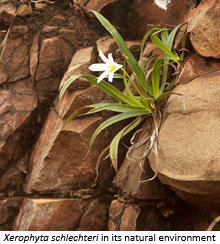- Radermacher AL, Du Toit SF, Farrant JM (2019) Desiccation-Driven Senescence in the Resurrection Plant Xerophyta schlechteri (Baker) N.L. Menezes: Comparison of Anatomical, Ultrastructural, and Metabolic Responses Between Senescent and Non-Senescent Tissues. Frontiers in Plant Science, 10. doi.org/10.3389/fpls.2019.01396
- Artur MAS, Rienstra J, Dennis TJ, Farrant JM, Ligterink W, Hilhorst H (2019) Structural Plasticity of Intrinsically Disordered LEA Proteins from Xerophyta schlechteri Provides Protection In Vitro and In Vivo. Frontiers in Plant Science, 10. doi.org/10.3389/fpls.2019.01272
- Artur MAS, Costa MC, Farrant JM, Hilhorst HWM (2019). Genome-level responses to the environment: plant desiccation tolerance. Emerging Topics in Life Sciences (2019) https://doi.org/10.1042/ETLS20180139.
- Bentley J, Moore JP, Farrant JM (2019) Metabolomic profiling of the desiccation-tolerant medicinal shrub Myrothamnus flabellifolia indicates phenolic variability across its natural habitat: Implications for tea and cosmetics production. Molecules, 24. doi.org/10.3390/molecules24071240
- Bentley J, Moore JP, Farrant JM (2019) Metabolomics as a complement to phylogenetics for assessing intraspecific boundaries in the desiccation-tolerant medicinal shrub Myrothamnus flabellifolia (Myrothamnaceae). Phytochemistry, 159: 127-136. doi.org/10.1016/j.phytochem.2018.12.016
- Charuvi D, Nevo R, Aviv-Sharon E, Gal A, Kiss V, Shimoni E, Farrant JM, Kirchhoff H, Reich Z (2019) Chloroplast breakdown during dehydration of a homoiochlorophyllous resurrection plant proceeds via senescence-like processes. Environmental and Experimental Botany, 157: 100-111. doi.org/10.1016/j.envexpbot.2018.09.027
- López-Pozo M, Flexas J, Gulías J, Carriquí M, Nadal M, Perera-Castro AV, Clemente-Moreno MJ, Gago J, Núñez-Olivera E, Martínez-Abaigar J, Hernández A, Artetxe U, Bentley J, Farrant JM, Verhoeven A, García-Plazaola JI, Fernández-Marín B (2019) A field portable method for the semi-quantitative estimation of dehydration tolerance of photosynthetic tissues across distantly related land plants Physiologia Plantarum. doi.org/10.1111/ppl.12890 (In press).
- Hilhorst HMW and Farrant JM (2018). Plant desiccation tolerance: A survival strategy with exceptional prospects for climate smart agriculture. Annual Plants Reviews online 1, 1–27 doi.org/10.1002/9781119312994.apr0637.
- Hilhorst HWM, Costa MCD, Farrant JM (2018) A Footprint of Plant Desiccation Tolerance. Does It Exist? Molecular Plant, 11: 1003-1005. doi.org/10.1016/j.molp.2018.07.001.
- Tshabuse F, Farrant JM, Humbert L, Moura D, Rainteau D, Espinasse C, Idrissi A, Merlier F, Acket S, Rafudeen MS, Thomasset B, Ruelland E (2018) Glycerolipid analysis during desiccation and recovery of the resurrection plant Xerophyta humilis (Bak) Dur and Schinz. Plant Cell and Environment, 41: 533-547. doi.org/10.1111/pce.13063
- Costa MC, Artur MAS, Maia J, Jonkheer E, Derks MFL, Nijveen H, Williams B, Mundree SG, Jiménez-Gómez JM, Hesselink T, Schijlen EGWM, Ligterink W, Oliver MJ, Farrant JM, Hilhorst HMW (2017) A ‘footprint’ of desiccation tolerance in the genome of the resurrection plant Xerophyta viscosa. Nature Plant 3, article number 17038| DOI: 10.1038/nplants.2017.38 | www.nature.com/natureplants.
- Costa MC, Cooper K, Hilhorst HMW, Farrant JM (2017) Orthodox seeds and resurrection plants: two of a kind? Plant Physiology. DOI:10.1104/pp.17.00760.
- Kamies R, Farrant JM Tadele Z, Cannarozzi G, Rafudeen MS (2017). A proteomic approach to investigate the drought response in the orphan crop Eragrostis tef. Journal of Proteome Research (in press).
- Nyau V, Prakash S., Rodrigues J and Farrant JM (2017). Domestic cooking effects of Bambara Groundnuts and Common Beans in the Antioxidant properties and Polyphenol Profiles. Journal of Food Research 6: 24-39. DOI: 10.5539/jfr.v6np24.
- Nyau V, Prakash S, Rodrigues J and Farrant J (2017). Profiling of Phenolic Compounds in Sprouted Common Beans and Bambara Groundnuts Journal of Food Research 6; 74-82. E-ISSN 1927-0895
- Barak S and Farrant JM (2016). Extremophyte adaptations to salt and water deficit stress. Functional Plant Biology 43: v-x. http://dx.doi.org/10.1071/FPv43n7_FO
- Zia A, Berkley JW, Oung HMO, Chavuri D, Jahns P, Cousins AB, Farrant JM, Reich Z, and Kirchoff H (2016). Protection of the photosynthetic apparatus against dehydration stress in the resurrection plant Craterostigma pumilim. The Plant Journal 87: 664-680. doi:10.1111/tpj.13227
- Costa MC, Farrant JM, Oliver MJ, Ligerink W, Buitink J and Hilhorst HMW (2016). Key genes involved in desiccation tolerance and dormancy across life forms. Plant Science 251:162-168 doi:10.1016/j.plantsci.2016.02.001.
- Ruelland E and Farrant JM (2015). Plant signalling mechanisms in response to the environment. Environmental and Experimental Botany 114: 1-3.
- Woodenburg WR, Pammenter NW, Farrant JM, Driouich A, Berjak P (2015) Embryo cell wall properties in relation to development and desiccation in the recalcitrant-seeded Encephalartos natalensis (Zamiaceae) Dyer and Verdoorn. Protoplasma, 252: 245-258.
- Nyau V, Rodridgues J and Farrant J (2015). Antioxidant activities of Bambara Groundnuts as Assessed by FRAP and DPPH assays. American Journal of Food and Nutrition, 3: 7-11.
- Nyau V, Prakash S, Rodrigues J and Farrant J (2015). HPLC-PDA-ESI-MS indentification of Polyphenolic Phytochemicals in different market classes of common bean (Phaseolus vulgaris L.). International Journal of Biochemistry Research & Review 8: 1-11.
- Nyau V, Prakash S, Rodrigues J and Farrant JM (2015). Identification of nutraceutical phenolic compounds in bambara groundnuts (Vigna subterranea L. Verdc) by HPLC-PDA-ESI-MS. British journal of applied science and technology, 6: 77-85.
- Moore JP and Farrant JM (2015) Editorial Current advances and challenges in understanding plant desiccation tolerance. Frontiers in Plant Science 6: article 768. DOI: 10.3389/fpls.2015.00768.
- Farrant JM, Dace HJW, Cooper K, Hilgart A, Peton N, Mundree SG, Rafudeen MS and Thomson JA (2015). A molecular physiological review of vegetative desiccation tolerance in the resurrection plant Xerophyta viscosa (Baker) with reference to biotechnological application for the production of drought tolerant cereals. Planta, 242: 407-426. DOI 10.1007/s00425-015-2320-6
- Charuvi D, Nevo R, Shimoni E, Navey L, Zia A, Farrant JM, Kirchoff H, Reich Z (2015). Photoprotection conferred by changes in photosynthetic protein levels and organization during dehydration of a homoiochlorophyllous resurrection plant. Plant Physiology 167: 1554-1565. DOI: 10.1104/pp:11425594.
- Plancot B, Vanier G, Maire F, Bardor M, Lerouge P, Farrant JM, Moore JP, Driouich A, Vicre-Gibouin M, Afonso C, Loutelier-Bourhis C (2014). Structural characterization of arabinoxylans from two African plant species Eragrostis nindensis and Eragrostis tef by MALDI-MS, ESI-MS, IM-MS and GC-MS. Rapid communications in Mass Spectrometry 28: 908–916.
|
|
Dr MS Rafudeen | Molecular and Cell Biology, University of Cape Town, South Africa.
Dr HWM Hilhorst | Honorary Research Associate, Molecular and Cell Biology, University of Cape Town, South Africa.
Assoc. Prof. Salme Timmusk | Swedish University of Agricultural Sciences
Dr JP Moore | Institute of Wine Biotechnology, University of Stellenbosch, South Africa.
Prof. Ndiko Ludidi | Dept of Biotechnology, University of Western Cape, South Africa.
Dr J Buitink | Institut de Recherche en Horticulture et Semences, INRA, Université d’Angers, France.
Prof SG Mundree | Centre for Tropical Crops and Biocommodities, Queensland University of Technology, Australia.
Prof MJ Oliver | Agricultural Research Services, United States Department of Agriculture, Missouri, USA.
Dr E Ruelland | Institut d'écologie et des sciences de l' environement de Paris CNRS, Université Paris-Est Créteil, France.
Prof. Ziv Reich | Biomolecular Sciences, Wiezmann Institute of Science, Israel.
Dr Robert VanBuren | Michigan State University, USA.
Dr Vincent Nyau | University of Zambia, Zambia.
|
|
Dr Givemore Makonya - Postdoctoral Research Fellow
Dr Elelwani Ramulifho - Postdoctoral Research Fellow
Dr Ademola Adetunji - Postdoctoral Research Fellow
Keren Cooper - Chief Scientific Officer | Lab manager - contact keren.cooper@uct.ac.za
Francois du Toit - PhD student | Functional studies of the resurrection plant Craterostigma pumilum.
Amogelang Tshego Gill - PhD student | While several ferns are desiccation tolerant, the mechanisms employed by them are largely unknown. The resurrection fern Anemia caffrorum has fronds that are desiccation tolerant in the dry, summer months and are desiccation-sensitive in the rainy, winter months. I investigate this interesting phenomenon using physiology and proteomics tools.
Farrah Kahn - PhD student | Transcriptional regulation of seasonal desiccation tolerance exhibited by the fern Anemia caffrorum
Joelle Ndongmo - PhD student | Molecular study of Xerophyta schlechteri and its associated microbiome to improve the resistance of crops to drought stress.
Mehafo Nepembe - PhD student | Characterization of GDP-mannose epimerase in Xerophyta viscosa.
Jean Felistas Ntuli - PhD student | Crops face simultaneous stresses and this project aims to identify and fully characterise the molecular elements (genes, DNA, RNA – transcriptome & protein – transcription factors) that paly a dual role in plant defence for both drought tolerance and resistance to fungal pathogens. Modelling resurrection plant Xerophyta viscosa to improve Maize crops.
Llewelyn van der Pas - PhD student | From proteome to biotechnology. Using the resurrection plant Eragrostis nindensis to genetically engineer drought tolerant crops
Shandry Tebele - PhD student | The functional role of root microbiome and root exudates associated with the resurrection plant–Myrothamnus flabellifolius
Achmat Williams - PhD student | A comparative physiology, proteomic and metabolomic study on four Bambara groundnut lines under drought stress
Erikan Baluku - MSc student | Understanding how the Bionano Saphyr equipment have advanced knowledge of the genomics aspect of Xerophyta schlechteri and add to techniques used already in the studying of the genome sequence of the species
Robyn Craythorne - MSc student | Structural and functional characterization of the newly termed 'Kc sites' within the Xerophyta humilis dehydrin, Xhlea2-5.
Unathi Dladla - MSc student | Examination of the microbial effects of Afrikelp fertilizers on crop productuvuty and drought tolerance
Armin Sadat Rezaei - MSc student | Enrichment and analysis of organelles in desiccation tolerant Craterostigma pumilum
Elisha Sinyinza - MSc student | Analysis and characterisation of long non-coding RNAs associated with desiccation tolerance in the resurrection plant Xerophyta schlechteri
Michael Wittenberg - MSc student | Investigation into the induction of desiccaiton tolerance in Anemia caffrorum
|









